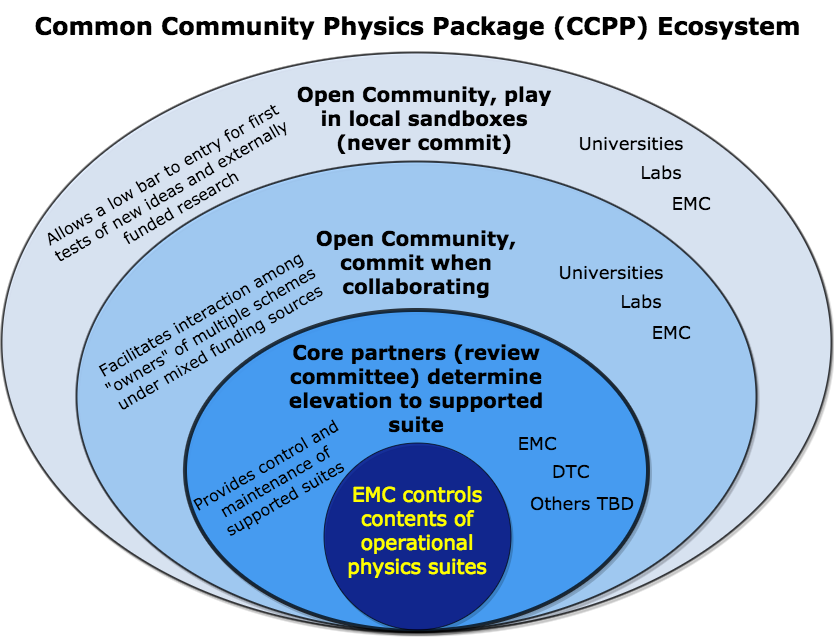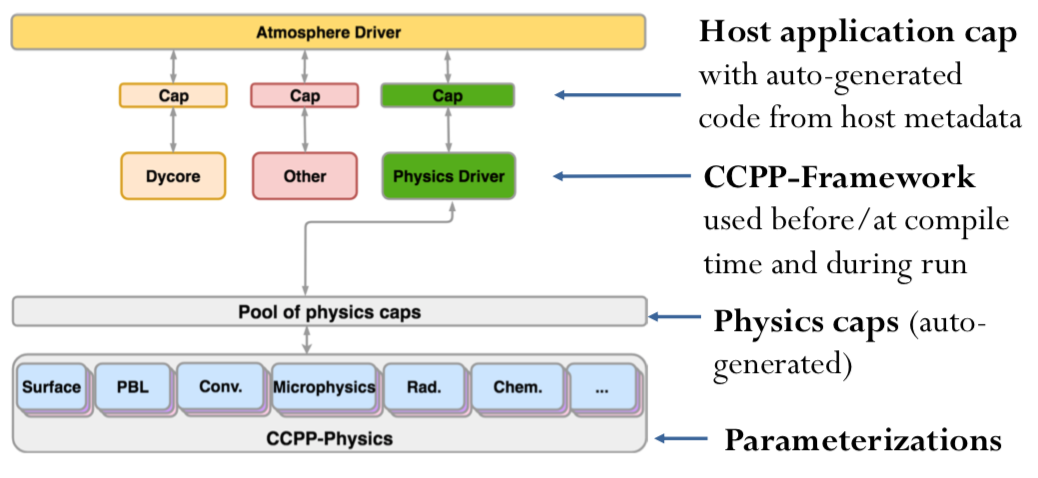Common Community Physics Package
Overview
Teaching: 0 min
Exercises: 0 minQuestions
What is a Physics Package?
Objectives
Learn about the Common Community Physics Package
Common Community Physics Package (CCPP) Ecosystem
- CCPP is designated to facilitate implementation of physics innovations in state-of-the-art atmospheric models, the use of various models to develop physics, and the acceleration of transition of physics innovations to operational models.
- There are two distinct parts to the CCPP:
- a library of physical parameterizations (CCPP-Physics) that conforms to selected standards, and an infrastructure (CCPP-Framework) that enables connecting the physics to a host model.
- There is also a CCPP single-column model (CCPP SCM) which is a simplified framework that enables experimentation in a controlled setting using forcing datasets originating from experimental field campaigns.

- The CCPP aims to support the broad community while benefiting from the community. In such a CCPP ecosystem, the CCPP can be used not only by the operational centers to produce operational forecasts, but also by the research community to conduct investigation and development. Innovations created and effectively tested by the research community can be funneled back to the operational centers for further improvement of the operational forecasts.
Common Community Physics Package (CCPP) System Architecture
- There are two distinct parts to the CCPP: a library of physical parameterizations (CCPP-Physics) that conforms to selected standards and an infrastructure (CCPP-Framework) that enables connecting the physics to a host model.

- The host model needs to have functional documentation for any variable that will be passed to or received from the physics. The CCPP-framework is used to compare the variables requested by each physical parameterization against those provided by the host model, and to check whether they are available, otherwise an error will be issued. This process serves to expose the variables passed between physics and dynamics, and to clarify how information is exchanged among parameterizations. During runtime, the CCPP-Framework is responsible for communicating the necessary variables between the host model and the parameterizations.
Key Points
Single Column Model
Overview
Teaching: 0 min
Exercises: 0 minQuestions
What is a single column model?
Objectives
Learn about the Common Community Physics Package - Single Column Model
What is a single column model?
- A single column model (SCM) can be a valuable tool for diagnosing the performance of a physics suite, from validating that schemes have been integrated into a suite correctly to deep dives into how physical processes are being represented by the approximating code.
- This SCM has the advantage of working with the Common Community Physics Package (CCPP), a library of physical parameterizations for atmospheric numerical models and the associated framework for connecting potentially any atmospheric model to physics suites constructed from its member parameterizations. In fact, this SCM serves as perhaps the simplest example for using the CCPP and its framework in an atmospheric model.
- The SCM code calls CCPP-compliant physics schemes through the CCPP framework code. As such, it requires the CCPP framework code and physics code, both of which are included as submodules within the SCM code. This package can be considered a simple example for an atmospheric model to interact with physics through the CCPP.
CCPP-SCM Overview
Key Points